In 1988, Ed Gould reported wing clapping (also described as the sound of rain drops falling) by Eonycteris spelaea roosting in total darkness in Batu caves near Kuala Lumpur, Malaysia, which ceased when the cave was illuminated. Bats living in a lighter part of the cave produced no sound. Gould painted one wing and showed that wings touched in flight. He also reported a whistling sound associate with wing clapping. However bats with plugged ears did not blunder into obstacles so Gould found it impossible to conclude definitively that wind clapping was a primitive sort of echolocation and he speculated that it may be associated with deceleration.
Arjan Boonman, Sara Bumrungsri and Yossi Yovel have extended Gould’s work to show that E.spelaea and Cynopterus brachyotis use wing clapping to detect and discriminate objects, although it does not allow them to estimate distance . Similar wing-clapping is reported in the bare-backed bat (Dobsonia moluccensis) and in Lucas’s dusky fruit bat (Panthetor lucasii) which also roosts in dark caves (Churchill 2008, T. Kingston pers. comm. respectively). Can any SEABCRU members extend these observations to other species?
Boonman, A., Bumrungsri, S. and Y. Yovel (2014) Nonecholocating fruit bats produce biosonar clicks with their wings. Current Biology. http://dx.doi.org/10.1016/j.cub.2014.10.077
Churchill SK (2008). Australian bats. Allen and Unwin, Sydney
Gould E (1988) Wing-clapping sounds of Eonycteris spelaea (Pteropodidae) in Malaysia. J Mammal 69:378–379

